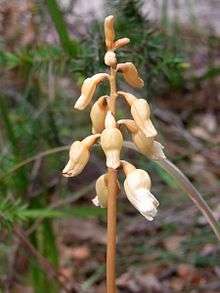Gastrodia sesamoides
Gastrodia sesamoides, commonly known as cinnamon bells or common potato orchid in Australia[2] and as the pot-bellied orchid or cinnamon sticks in New Zealand,[3] is a leafless, terrestrial saprophytic orchid in the family Orchidaceae. It has a thin, fleshy brown flowering stem and up to twenty five drooping, brownish, self-pollinating flowers that are white inside. Growing in a wide range of habitats, it is native to Australia and New Zealand.
| Cinnamon bells | |
|---|---|
 | |
| Gastrodia sesamoides in Ku-ring-gai Chase National Park | |
| Scientific classification | |
| Kingdom: | Plantae |
| Clade: | Tracheophytes |
| Clade: | Angiosperms |
| Clade: | Monocots |
| Order: | Asparagales |
| Family: | Orchidaceae |
| Subfamily: | Epidendroideae |
| Tribe: | Gastrodieae |
| Genus: | Gastrodia |
| Species: | G. sesamoides |
| Binomial name | |
| Gastrodia sesamoides | |
Description
Gastrodia sesamoides is a leafless, terrestrial saprophyte with an underground rhizome up to 80 mm (3 in) long and 30 mm (1 in) in diameter. The thin, fleshy brown flowering stem is 12–75 cm (5–30 in) tall with between three and six bracts 4–10 mm (0.2–0.4 in) long and between three and twenty five flowers. The flowers are cinnamon brown to greyish brown and often rough on the outside, white inside with the sepals and petals joined to form a bell-shaped tube 15–20 mm (0.6–0.8 in) long. Each flower has a pedicel or "stalk" 2–10 mm (0.08–0.4 in) long and a cone-shaped ovary with the narrower end towards the base. The flowers often produce an appealing cinnamon-like scent. Flowering occurs from September to January in Australia and from August to May in New Zealand, but the flowers are self-pollinating. Flowering is enhanced by fire the previous summer.[2][3][4][5][6]
Taxonomy and naming
Gastrodia sesamoides was first formally described in 1810 by Robert Brown and the description was published in his book Prodromus Florae Novae Hollandiae.[7][8] The specific epithet (sesamoides) refers to a supposed similarity to the sesame plant, the ending -oides being a Latin suffix meaning "like", "resembling" or "having the form of".[9]
Distribution and habitat
Cinnamon bells is widespread and common, occurring south from the Darling Downs through the eastern half of New South Wales and the southern half of Victoria to Tasmania. It used to be found in the Sydney region but is now considered rare or extinct in that area. It is only found in the far southeast of South Australia, including on Kangaroo Island. It occurs on both the North and South Islands of New Zealand although only in the Marlborough and Nelson areas of the South Island. It grows in a wide variety of habitats, including forest and coastal scrub from lowland areas to subalpine habitats as long as there is adequate rainfall or soil moisture. In New Zealand it is often found in forestry plantations and in gardens where pine bark mulch is used.[2][3][5][6][10]
Ecology
Because the potato orchid doesn’t produce chlorophyll it is unable to make its own food via photosynthesis. Alternatively, it has a complex relationship with a fungus. The orchid receives its nutrients from the fungus, and the fungus obtains its habitat from the orchid and minerals and sugars from the roots of other forest trees.[11]
Gastrodia sesamoides has been introduced to and is naturalised in South Africa.[12][13]
Conservation
This orchid is common and widespread throughout most of its range but is classed as "rare" in South Australia.[14]
Uses
Use as food
Indigenous Australians ate the roasted tubers of this orchid and it may have been one of the principal plants used by Tasmanian Aborigines.[15][16] An early Victorian settler reported that Aboriginal peoples located the plants in habitat by observing where bandicoots had scratched in search of the tubers after detecting the plants underground by scent.[17] The flavour of the tuber is said to resemble that of the beetroot, though insipid and watery.[15][18]
Use in horticulture
Cultivation of all species of Gastrodia is impossible.[2]
References
- "Gastrodia sesamoides". World Checklist of Selected Plant Families (WCSP). Royal Botanic Gardens, Kew.
- Jones, David L. (2006). A complete guide to native orchids of Australia including the island territories. Frenchs Forest, N.S.W.: New Holland. p. 371. ISBN 1877069124.
- "Gastrodia sesamoides". New Zealand Plant Conservation Network. Retrieved 10 November 2018.
- Fairley, Alan; Moore, Philip (2000). Native Plants of the Sydney District:An Identification Guide (2nd ed.). Kenthurst, NSW: Kangaroo Press. p. 390. ISBN 0-7318-1031-7.
- "Gastrodia sesamoides". Royal Botanic Gardens Victoria. Retrieved 10 November 2018.
- Weston, Peter H. "Gastrodia sesamoides". Royal Botanic Garden Sydney. Retrieved 10 November 2018.
- "Gastrodia sesamoides". APNI. Retrieved 10 November 2018.
- Brown, Robert (1810). Prodromus florae Novae Hollandiae et Insulae Van-Diemen. London. p. 330. Retrieved 10 November 2018.
- Brown, Roland Wilbur (1956). The Composition of Scientific Words. Washington, D.C.: Smithsonian Institution Press. p. 483.
- Robinson, Les (1991). Field guide to the native plants of Sydney. Kenthurst, N.S.W.: Kangaroo Press. pp. 127–128. ISBN 0864171927.
- "Potato orchid". Te Ara - The Encyclopedia of New Zealand. Retrieved 16 September 2019.
- "Potato Orchid (Gastrodia sesamoides)". iNaturalist.org. Retrieved 10 November 2018.
- "Gastrodia sesamoides". State Herbarium of South Australia. Retrieved 10 November 2018.
- "Gastrodia sesamoides" (PDF). Government of South Australia Department for Environment and Heritage. Retrieved 10 November 2018.
- Cribb, Alan B.; Cribb, Joan W. (1974). Wild Food in Australia. Australia: Collins. p. 149. ISBN 0006344364.
- "Potato Orchid". Plant Use. Australian National Botanic Gardens. Retrieved 11 October 2011.
- "Potato orchid". Australian National Botanic Gardens. Retrieved 23 January 2019.
- "Potato Orchid". Aussie Gardening. Archived from the original on 30 December 2012. Retrieved 11 October 2011.
External links
